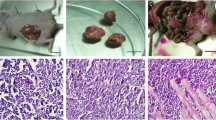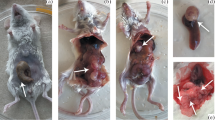Abstract
An ultra-high metastatic model of human colon cancer was developed in order to represent highly malignant patient disease for which there is no current model. Surgical orthotopic implantation (SOI) of a histologically intact liver metastasis fragment derived from a surgical specimen of a patient with metastatic colon cancer was initially implanted in the colon, liver and subcutaneously in nude mice. This tumor did not metastasize for the first 10 passages. At the eleventh passage, the tumor exhibited metastasis from the colon to the liver, spleen, and lymph nodes. At this time, two selective passages were carried out by transplanting resulting liver metastases in the nude mice to the colon of additional nude mice. After these two passages, the tumor became stably ultra-metastatic and was termed AC3488UM. One-hundred percent of mice transplanted with AC3488UM with SOI to the colon exhibited local growth, regional invasion, and spontaneous metastasis to the liver, lymph nodes, and spleen. While the maximum size of the primary tumor was 0.9 g, the metastatic liver was over 9 times the weight of the normal liver with the maximum weight of the metastatic liver over 12 g. Liver metastases were detected by the tenth day after transplantation in all animals. Half the animals died of metastatic tumor 25 days after transplantation. Histological characteristics of AC3488UM tumor were poorly differentiated adenocarcinoma of colon. Mutant p53 is expressed heterogeneously in the primary tumor and more homogeneously in the liver metastasis suggesting a possible role of p53 in the liver metastasis. The human origin of AC3488UM was confirmed by positive fluorescence staining for in situ hybridization of human DNA. The AC3488 human colon-tumor model with its ultra-high metastatic capability in each transplanted animal, short latency and a short median survival period is different from any known human colon cancer model and will be an important tool for the study of and development of new therapy for highly metastatic human colon cancer.
Similar content being viewed by others
References
Aznavoorian S, Murphy AN, Steteler-Stevenson WG, Liotta LA. Molecular aspects of tumor cell invasion and metastasis. Cancer 1993; 71: 1368–83.
Furukawa T, Fu X, Kubota T, et al. Nude mouse metastatic models of human stomach cancer constructed using orthotopic implantation of histologically intact tissue. Cancer Res 1993; 53: 1204–8.
Sharkey FE, Fogh J. Considerations in the use of nude mice for cancer research. Cancer Metastasis Rev 1984; 3: 341–60.
Fidler IJ. Critical factors in the biology of human cancer metastasis: Twenty-eighth G.H.A. Clowes Memorial Award Lecture. Cancer Res 1990; 50: 6130.
Manzotti C, Audisio RA, Pratesi G. Importance of orthotopic implantation for human tumors as model systems: relevance to metastasis and invasion. Clin Exp Metastasis 1993; 11: 5–14.
Hoffman RM. Orthotopic is orthodox: why are orthotopic-transplant models different from all other models? J Cell Biochem 1994; 56: 1–4.
Fu X, Besterman JM, Monosov A, Hoffman RM. Models of human metastatic colon cancer in nude mice orthotopically constructed by using histologically-intact patient specimens. Proc Natl Acad Sci USA 1991; 88: 9345–49.
Wang X, Fu X, Hoffman RM. A new patient-like metastatic model of human lung cancer constructed orthotopically with intact tissue via thoracostomy in immunodeficient mice. Int J Cancer 1992; 51: 992–5.
Fu X, Theodorescu D, Kerbel RS, Hoffman RM. Extensive multiorgan metastasis following orthotopic implantation of histologicallyintact human bladder carcinoma tissue in nude mice. Int J Cancer 1991; 49: 938–9.
Fu X, Guadagni F, Hoffman RM. A metastatic nude-mouse model of human pancreatic cancer constructed orthotopically from histologically-intact patient specimens. Proc Natl Acad Sci USA 1992; 89: 5645–9.
Fu X, Herrera H, Hoffman RM. Orthotopic growth and metastasis of human prostate carcinoma in nude mice after transplantation of histologically intact tissue. Int J Cancer 1992; 52: 987–90.
Fu X, Hoffman RM. Human ovarian carcinoma metastatic models constructed in nude mice by orthotopic transplantation of histologically-intact patient specimens. Anticancer Res 1993; 13: 283–6.
Sun FX, Tang ZY, Liu KD et al. Establishment of a metastatic model of human hepatocellular carcinoma in nude mice via orthotopic implantation of histologically intact tissues. Int J Cancer 1996; 66: 239–43.
Sun FX, Tang ZY, Liu KD et al. Metastatic models of human liver cancer in nude mice orthotopically constructed by using histologically intact patient specimens. J Cancer Res Clin Oncol 1996; 122: 397–402.
Cowen SE, Bibby MC, Double JA. Characterisation of the vasculature within a murine adenocarcinoma growing in different sites to evaluate the potential of vascular therapies. Acta Oncologica 1995; 34: 357–60.
Chromosome in Situ Hybridization Manual, Oncorr, Gaithersburg, MD 20877.
Fidler IJ. Rational and methods for the use of nude mice to study the biology and therapy of human cancer metastasis. Cancer Metastasis Rev 1986; 5: 29–49.
Giavazzi R, Jessup JM, Campbell DE et al. Experimental nude mouse model of human colorectal cancer liver metastases. J Natl Cancer Inst 1986; 77: 1303–8.
Beresalier RS, Raper SE, Hujanen ES, Kim YS. A new animal model for human colon cancer metastasis. Int J Cancer 1987; 39: 625–30.
Morikawa K, Walker SM, Jessup JM, Fidler IJ. In vivo selection of highly metastatic cells from surgical specimens of different primary human colon carcinoma implanted into nude mice. Cancer Res 1988; 48: 1943–8.
Morikawa K, Walker SM, Nakajima M et al. Influence of organ environment on the growth, selection, and metastasis of human colon carcinoma cells in nude mice. Cancer Res 1988; 48: 6863–71.
Hoffman RM. Patient-like models of human cancer in mice. Curr Per Mol Cel Oncol 1992; 1: 311–26.
Kuo T-H, Kubota T, Watanbe M et al. Liver colonization competence governs colon cancer metastasis. Proc Natl Acad Sci USA 1995; 92: 12085–9.
Paget, S. The distribution the secondary growths in cancer of the breast. Lancet 1889; i: 571–3.
Fu X, Herrera H, Kubota T, Hoffman RM. Extensive liver metastasis from human colon cancer in nude and Scid mice after orthotopic onplantation of histologically intact human colon carcinoma tissue. Anticancer Res 1992; 12: 1395–8.
Kuo TH, Kubota T, Watanabe M et al. Early resection of primary orthotopically-growing human colon tumor in nude mouse prevents liver metastasis: further evidence for patient-like hematogenous metastatic route. Anticancer Res 1993; 13: 293–8.
Konno H, Tanaka T, I et al. Comparison of the inhibitory effect of the angiogenesis inhibitor, TNP-470, and mitomycin C on the growth and liver metastasis of human colon cancer. Int J Cancer 1995; 61: 268–71.
Tanaka T, Konno H, Matsuda I et al. Prevention of hepatic metastasis of human colon cancer by angiogenesis inhibitor TNP-470. Cancer Res 1995; 55: 836–9.
Konno H, Tanaka T, Kanai T et al. Efficacy of an angiogenesis inhibitor, TNP-470, in xenotransplanted human colorectal cancer with high metastatic potential. Cancer 1996; 77: 1736–40.
Nigro JM, Baker JS, Preisinger AC et al. Mutations in the p53 gene occur in diverse human tumor types. Nature 1989; 342: 105–8.
Author information
Authors and Affiliations
Rights and permissions
About this article
Cite this article
Sun, F.X., Sasson, A.R., Jiang, P. et al. An ultra-metastatic model of human colon cancer in nude mice. Clin Exp Metastasis 17, 51–58 (1999). https://doi.org/10.1023/A:1026442321295
Issue Date:
DOI: https://doi.org/10.1023/A:1026442321295




